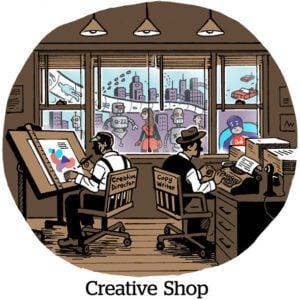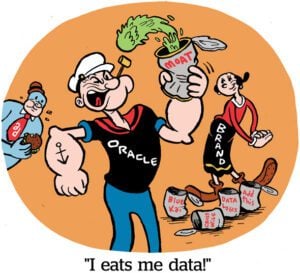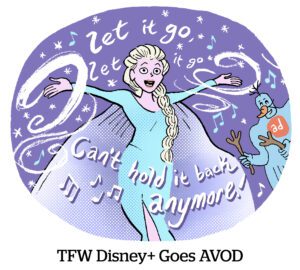The two minutes of television inventory sold by multichannel video players (MVPDs) – which can be made addressable by targeting through the set-top box – has historically been fragmented across providers, making it complex for a national advertiser to run addressable campaigns at scale.
Today, MVPDs are jockeying to sell each other’s addressable TV supply, and NCC Media, majority-owned by Comcast, and AT&T’s Xandr unit have risen as frontrunners.
Both companies, headed up by former Xaxis exec Nicolle Pangis at NCC and Brian Lesser at Xandr, agree they’re making a similar play for more addressable inventory.
And both deny they’re competitive with each other. AT&T, after all, is a major NCC customer.
NCC is a sales consortium between Comcast, Cox and Charter, all three of which use it to sell inventory, as do most major MVPDs and 200 local TV networks. NCC sells across 85 million US homes, 45 million of which are addressable.
Xandr sells addressable TV across DirecTV’s 19 million satellite homes, and last September signed exclusive deals to represent addressable inventory from Altice, which covers the tri-state area, and Frontier, which covers small and medium-sized markets along the east coast. The deal brings Xandr’s reach to 18 million homes. (Interestingly, NCC is the exclusive sales rep for DirecTV and Altice in the local linear markets, showing how intertwined the MVPD landscape is.)
Xandr-owned AppNexus can also supplement its TV supply with cross-platform media, and has access to premium supply through WarnerMedia, including Turner Networks, where it’s already activating AT&T set-top box data. Xandr also reaches 1.6 million OTT subscribers on DirecTV Now.
Sources tell AdExchanger that NCC’s and Xandr’s methods of aggregating addressable inventory and insights are very different. While NCC is more collaborative, trying to work with cable operators to develop a data management platform-like solution for TV, Xandr is on the hunt for exclusive deals.
“AT&T is used to pushing their weight around,” said Jane Clarke, managing director at the Coalition for Innovative Media Measurement.
As impressive as their scale is, neither player has complete coverage of US addressable households, as Dish and Verizon sell their supply independently.
The ultimate goal is to grab the remaining 14 minutes of inventory sold by broadcast and cable networks and make that supply addressable. Xandr is already leveraging its ties to WarnerMedia and using carriage agreements with networks like Viacom to access more national minutes.
“There’s going to be fighting to get more impressions to be addressable,” said Tracey Scheppach, CEO and co-founder at Matter More Media. “This is a battle, and these players don’t play nice.”
But TV networks with a fierce history of competition are unlikely to want to hand their supply over to NCC or Xandr.
“The TV companies are frenemies,” Clarke said. “They know it would be better if they could put their inventory together, but they all want to own the platform.”
Xandr vs. NCC
There are nuances to the type of buy both Xandr and NCC Media can offer.
Xandr’s inventory is mostly live linear and makes up “the largest representation of live inventory in the linear addressable marketplace,” said Amy Leifer, head of sales planning and operations at Xandr.
Live linear inventory is currently more appealing to buyers than video on demand (VOD).
“VOD is watched differently than linear,” Scheppach said. “It’s hard to predict if the household will show up, so it’s harder to deliver the impressions.”
NCC, on the other hand, has more VOD than live linear supply, which has its limitations for addressable buyers, said Sam Rose, SVP of video investment and advanced TV at Horizon Media. (NCC said live linear is its fastest-growing bucket of inventory and expects it to surpass VOD next year.)
“A lot of homes don’t watch set-top box on demand,” she said.
And while NCC’s presence in local markets gives it broader reach across addressable homes, it also competes with its owners’ and affiliates’ local buying teams for inventory to sell.
“There’s not a hard allocation of inventory,” said Andrew Ward, president at NCC Media. “NCC comes into play when an advertiser wants to buy multiple markets. We can harmonize and unify those markets such that that advertiser doesn’t need to pull that together.”
Unlike Xandr, NCC doesn’t own any technology, data or inventory itself, but reps it for other companies. And some industry insiders worry that Comcast’s majority ownership of NCC might create bias, and that Comcast’s ambitions with FreeWheel could eventually conflict with Pangis’ goals for NCC.
“Comcast is the linchpin,” Clarke said. “Whatever they do with their inventory is huge.”
But when it comes to managing complex multi-market campaigns, NCC has decades of experience, said Simulmedia CEO Dave Morgan.
“They have expertise doing multi-company campaigns,” he said. “Now they’re adding digital and addressable, which are newer and bigger missions.”
The outliers
Dish, which reaches 12 million homes and has OTT inventory on Sling TV, and Verizon, which reaches more than 15 million homes through FiOS, have not aligned with NCC or Xandr.
But Dish has a history of partnering with DirecTV. The two satellite operators go to market with an addressable solution for political advertising called D2, for example. Verizon, Dish and DirecTV also all use INVIDI as their video ad server, making it less of a technical challenge to rep each other’s inventory. Comcast uses Visible World, which it bought in 2015.
“The product is consistent on DirecTV and Dish,” Scheppach said. “You can get national scale in a consistent way, you can bring clients’ first-party data and target the same way.”
NCC declined to comment about whether it’s trying to sign rep deals with Dish and Verizon. Xandr’s Leifer said, “we’re looking to grow our footprint.”
But aggregating addressable supply is more complicated than signing a rep deal. MVPDs use different technology, pricing, reporting and measurement, and as buyers get more sophisticated in addressable, working with multiple technologies could get messy.
“It’s one thing to make a joint buy with an off-the-shelf-segment,” said Mike Bologna, President at Cadent. “It gets complicated when you’re creating custom segments that need to be matched against various systems, measured through the same provider and brought together.”
The end game
Despite their growing scale, the game doesn’t end with Xandr, NCC, Dish and Verizon.
Networks are finding ways to make their supply addressable without MVPDs. Project OAR, a consortium launched in March by Vizio and major TV networks, aims to use and automatic content recognition technology (ACR) to define technical standards for addressable TV ad sales and deliver addressable ads across Vizio’s 10.5 million smart TVs by 2020.
And Nielsen is making its own addressable TV play with Sorenson Media, the advanced TV platform it acquired in February; Gracenote, the ACR technology it acquired in 2016; and TV privacy software Qterics, which is embedded in 90 million homes.
But it’s early days for those efforts, leaving the rest of the $70 billion TV market that’s not yet addressable up for grabs.
“Very little has ever been bought that way,” Scheppach said. “There are a lot of technical hurdles.”
While the industry shakes out, what’s clear is buyers will want a less fragmented way to access addressable TV, and both Xandr and NCC want to own that consolidated platform.
“It’s great to know that you’re talking with one voice in the market,” Leifer said. “That’s what it’s all about for advertisers.”
Today, the ecosystem is manageable, Horizon’s Rose said. But addressable spend is still low and buyers are mostly obscured from the complexities of aggregating supply. As digital buyers accustomed to working with digital platforms enter the advanced TV space, they’ll have less patience for fragmentation, Bologna said.
“Agencies will be looking for a platform-based solution,” he said. “There’s certainly a need for consolidated representation.”












